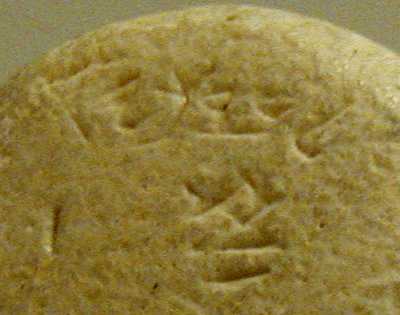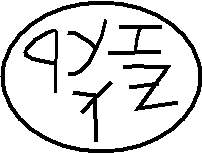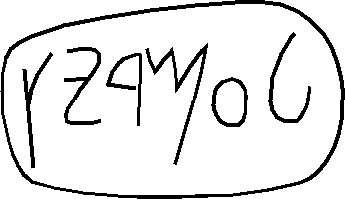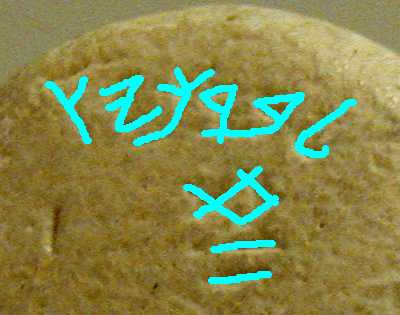After last week's post, Michael Welch & David Hendin asked some interesting questions, so I'll clarify a few things that future readers may wonder about as well:
1) I only took a single photo of the object; all the photos in the past 2 blogs were derivations of it. Here's the overall image:
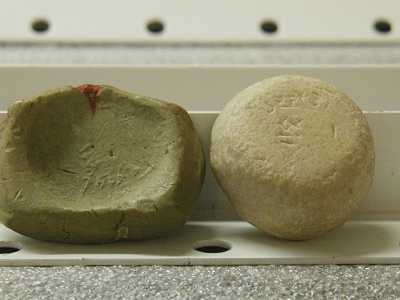
2) As you can see, I didn't bring a scale with me to include in the photo. Fortunately, Rabbi Glueck did. I cited his metric measurements in the first blog, but in SI units, the object is about 1.25" diameter, & the height varies from about 0.4-0.5". It's like a hockey puck in shape, not in size. The Roman-era "Bar Kathros" weight in "Discovering Jerusalem" (by Nahman Avigad; pp. 130-1) is like a puck in both shape & size.
3) The likelihood of it being a fake or forgery is extremely slim. If someone were knowledgeable enough to inscribe a Paleo-Hebrew name in mirror image to market or promote a Biblical antiquity, they would certainly have spelled the name as it appears in the Bible, either "BRKYE" or BRKYEU", not "BRKY", & DEFINITELY not "BRKYU" before the famous Tel Dan handles shown in last week's blog were discovered decades later.
4) Several of the traditional types of Judean weights were found at Lachish including six of the 4-shekel variety with the sheqel symbol, sometimes formed with straight/angular lines, sometimes rounded. "Lachish III, The Iron Age, Plates" (1953, Plate 51:1-6) shows 3 angular & 3 round. In "Guide to Biblical Coins", David Hendin classified this type as "W9" & dated it to "9-7 centuries B.C.E." Another angular one was excavated from Gibeon ("Hebrew Inscriptions & Stamps from Gibeon" by James B. Pritchard, 1959, Fig. 12:6-7). The Nebi-Rubin specimen is angular but was made via 4 incisions, whereas the Gibeon one was made via 3.
5) As far as I know, Nabi/Nebi-Rubin has never been excavated (not listed in "The New Encyclopedia of Archaeological Excavations in the Holy Land", 1993), so we don't know its full stratigraphy.
Here are David Hendin's observations:
The photo of the object you sent me with inscription is very strange and there are many unusual factors in the object and its description.
First, in general this form of weight (hockey puck shape) is not related to the Iron Age, but to the Roman period, similar to many weights found in the "burnt house" and nearby. On the other hand, in my upcoming book, I describe a weight (48.14 g) of this general shape (without inscription) as a possible Iron Age weight.
Second, when the dome shaped Judean weights are found, the inscription of denomination is 99% of the time on the TOP of the dome and not on a flat base.
Third, I am not familiar with any other limestone dome weights of Judah which are inscribed EXCEPT with the denomination of shekels or fractions of shekels.
Fourth, the data you cite on the shekel symbol, which looks kind of like a figure-8 with open top, is outmoded. Scott's interpretation of the "sror" is quite old (though interesting). In 1966 [Yohanan] Aharoni proved these markings (except the words for beqa, pym, and nezef) to be hieratic numerals. More recently [Raz] Kletter pointed out that the shekel symbol itself is a kind of hieratic shortening for the word "shekel." (This is involved in a close relationship between the Judean shekel of late 8th to early 6th cen. BCE and the Egyptian qedet of the same period.)
Fifth, the proven age of the limestone shekel weights is from the VERY END of the 8th century BCE until 586 BCE.
The style of the so-called inscription on this piece is in fact a much earlier style of inscription, at least 100 years earlier.
Finally, I would tend to disagree that the "bet" - "resh" letters constitute a ligature, which most frequently is a kind of short-hand combination of two letters. In this case there is simply an overlap.
Is there an actual record of this piece being excavated? The exact location of the find? I find the piece to have rather a lot of anomalies (although the actual weight of the piece is within the range of 2 shekels for the late 8th century to 586 BCE period).
Given the circumstances of the discovery of the piece, it seems unlikely that it is a forgery, but stranger things have happened. Whatever the circumstances it is certain that you have re-discovered a most interesting object that absolutely deserves further study.
Best wishes.
David Hendin
My answer to David's question about the excavation & find-spot was reported in my initial blog 2 weeks ago. It was found during a surface survey just like the famous Gezer Calendar inscription, & the LMLK ostracon from Tell Qasile.
Although David does not suspect that this weight was forged, some other readers out there might, so I'll conclude with this point: If it was forged by Rabbi Glueck or one of his friends, apparently it is the only artifact of this type they bothered to fake, & they gained absolutely nothing from it aside from the embarrassment of choosing all the wrong characteristics:
- a 9th-century inscription for...
- an 8th-century personal seal on...
- a 7th-century weight in...
- a Roman-era shape!!!
And the kicker is that in BASOR 153 he said it must be from the Persian-Hellenistic era!!!
It's like the Laetoli footprints of modern humans smack dab in the middle of a rock believed to be 3.7 million years old! Sometimes we only have 1% of the puzzle when we think we have 99% of it. It's like cosmologists talking about the observable portion of the universe as if it's the whole thing, when actually it might only be a thread dangling from the edge of a far more magnificent garment.
Song of the week: "Wait For Me" by Vangelis (click the song title to visit Amazon; click here for a 28-second sample; 360kb).
G.M. Grena
